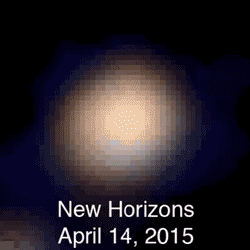Pluto revealed
New images give closest look ever at the dwarf planet and its moons
9-1/2 years, 3 billion miles and $700 million later, humanity has finally reached Pluto. New images released by NASA show detailed views of the the Pluto system.

Four images from New Horizons released June 24 show the sharpest resolution of Pluto yet.
Newest images:

This synthetic perspective view of Pluto, based on the latest high-resolution images from NASA’s New Horizons spacecraft, shows what you would see if you were approximately 1,100 miles (1,800 kilometers) above Pluto’s equatorial area.

A mosaic of Sputnik Planum, sent back from NASA's New Horizons spacecraft from Sept. 5 to 7, 2015. The smooth, bright region across the center of Pluto is dominated in icy plain. This image also features a tremendous variety of other landscapes surrounding Sputnik.

A halo of Pluto's atmosphere is backlit by the sun, captured by NASA's New Horizons around midnight EDT on July 15.

New Horizons scientists use exaggerated color to illustrate differences in the composition and texture of Pluto’s surface.

This composite photo shows the southwest region that shapes Pluto's heart. The Tombaugh Region contains frozen peaks estimated to be 0.5-mile to 1-mile high, about the same height as the United States’ Appalachian Mountains. The Norgay Mountains, which are estimated to be as high as 11,000 feet more closely approximate the height of the taller Rocky Mountains.

Remarkable new details of Pluto’s largest moon Charon are revealed in this image from New Horizons’ Long Range Reconnaissance Imager (LORRI).

How large Pluto and Charon would appear if placed above Earth's surface.
An evolution of our view of Pluto over the years

















The little machine that could: New Horizons' journey to Pluto
New Horizons is the fastest spacecraft ever launched, reaching lunar orbit distance in just nine hours and passing Jupiter 13 months later. The spacecraft operates on less power than a pair of 100-watt household light bulbs.

To orbit Pluto, New Horizons would have required almost 70,000 pounds of fuel to slow down to nearly the same velocity as the dwarf planet. The craft weighed just over 1,000 pounds at launch.


Pluto and Charon - a binary planet
Pluto and its largest moon Charon form what astronomers call a binary planet. Instead of the moon orbiting around the dwarf planet, Charon and Pluto orbit around a gravitational point between the two bodies. Read more>>
How big is Charon?

How do Pluto and Charon move?

Sources: NASA EPA, John Hopkins University Applied Physics Laboratory. Graphics by Raoul Ranoa and Kyle Kim. Graphics reporting by Deborah Netburn. Design by Priya Krishnakumar and Kyle Kim.